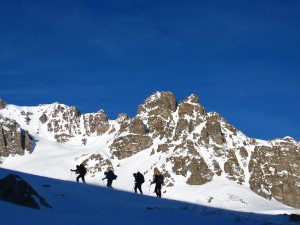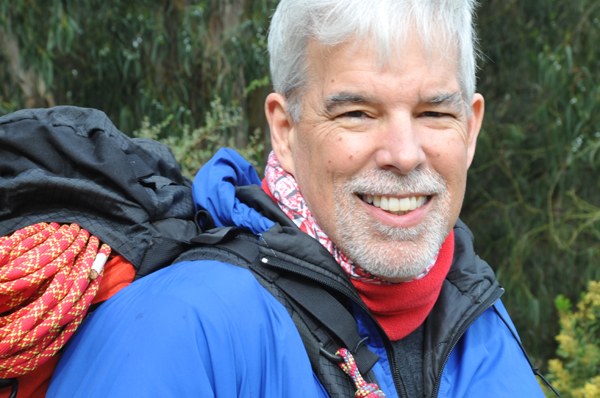We spoke with Matt Brooks’ of Brooks-Range, whose goal is to educate outdoor enthusiast to be aware of their surroundings when venturing into the backcountry.
As the founder of Brooks Range Mountaineering Equipment Co., Matt Brooks is a savvy business man, but also a driving force for the outdoor adventure community. His goal is to provide safety instruction and tools for those entering into the backcountry and has successfully manufactured and improved upon many pieces of equipment that are widely used by mountain guides across the country.
An experienced mountaineer, certified mountain guide and a member of the American Mountain Guides Association, Brooks considers backcountry safety a growing concern. “More and more people are using the backcountry,“ he says. “We think it’s great that people value this irreplaceable resource, and we want to make it safer for them to enjoy it.”
But as more people venture into the backcountry of resorts, state and national parks, there are increasing injuries and deaths each year. In a January 2009 report in the Mountain News, a newsletter for the mountain resort industry, many ski resorts are struggling with the need for personal responsibility and awareness of the trouble that may arise when people head into the backcountry unprepared. As an example, a report by the Northwest Weather and Avalanche Center shows that in the winter of 2008/2009, a total of 28 avalanche fatalities were reported. Most were from snowmobilers, back country skiers, and skiers using the resort’s ski lifts who ventured out too far.
“In the end, the best and most important tool is your brain. After that, a good foundation and training will help you survive.”-Matt Brooks
While many outdoor enthusiasts seek the thrill of virgin snow or backpacking into very secluded areas, Brooks says that the biggest problem is that people venture into the backcountry unprepared. “An accident is not an accident,” says Brooks. “It’s a series of bad decisions, with an outcome that could have been avoided.”
While Brooks-Range provides many tools that can help outdoor enthusiasts in a backcountry situation, Brooks reminds us that the tools are there to assist and not take the place of proper education. “Gear will not save you if you don’t know how to use it. You have to be self reliant. In the end, the best and most important tool is your brain. After that, a good foundation and training will help you survive.”
No matter what type of situation you find yourself in, Brooks recommends some basic advice. The first is to stay where you are. If you have some kind of shelter, put it in place to shield yourself from the weather. Brooks also recommends determining where you are by using a map and compass. If people know you were venturing out, they will eventually notify the proper authorites and a search will begin.
 Most search and rescue teams will have experienced mountain guides that know the area well, and carry essential tools to help you; especially if you are injured. For skiers and snowboarders, injuries are the most common. That’s one of the reasons why Brooks developed the company’s popular and lightweight rescue sleds. “We’re working on a new design of a rescue sled for mechanized skiing, heli, and snow cat skiing,” says Brooks. “We’re also updating the old designs, which is typical for us, and something our customers often comment on. We’re just never satisfied with the status-quo…which is frankly why the company exists in the first place.”
Most search and rescue teams will have experienced mountain guides that know the area well, and carry essential tools to help you; especially if you are injured. For skiers and snowboarders, injuries are the most common. That’s one of the reasons why Brooks developed the company’s popular and lightweight rescue sleds. “We’re working on a new design of a rescue sled for mechanized skiing, heli, and snow cat skiing,” says Brooks. “We’re also updating the old designs, which is typical for us, and something our customers often comment on. We’re just never satisfied with the status-quo…which is frankly why the company exists in the first place.”
After many years as a mountain guide and performing countless rescues, we asked Brooks if there were any that were more memorable than others. “I try to avoid what is known as sagas,” he says. “But there is one particular incident in the high alpine mountains of the European Alps, on a heli rescue. There was bad weather closing in fast and I repelled from a helicopter to assist two hikers who were lost and already suffering from extreme hypothermia. The conditions would not permit the helicopter to land until the storm would pass. So I knew we would be spending the night. We used a bivvy sack and hoped to make it until morning. Administering improvised first-aid the hikers survived the night and were taken to the hospital after the storm cleared the following day. To this day, they’ve been very grateful and I’ve received holiday cards from those two hikers ever since. “
We also asked Brooks what Brooks-Range product he might recommend most to anyone, experienced or not, to take with them into the backcountry. His response was the Brooks-Range Ultra-lite Tarp. “I like the tarps because they are multi-functional tools that can be used as everything from a bivi sack shelter to a sun screen or even an emergency sled.”
While many of the products Matt Brooks has designed and created are used by most search and rescue teams and mountain guides, most of the products can also be used in any outdoor environment. “We’re considering a line of summer products that will specifically target backcountry hikers and backpackers,” says Brooks. “But I specifically recommend anyone who wants to venture into the backcountry, to seek professional training. There are many clubs and groups that can offer a variety of classes depending upon the activity,” he says.
In the USA, Brooks-Range Mountaineering specifically recommends the American Mountain Guides Association, but there are a number of mountain guide training schools and classes available that can give you some basic skills in learning how to read maps, access snow conditions for avalanches and much more. In the end, training and preparedness will ultimately lead to your own safety, as well as the safety of others venturing into the backcountry to get their fix for outdoor adventure.
By Dan Sanchez
For more info: Brooks-Range Mountaineering Equipment Co. www.brooks-range.com American Mountain Guides Association www.amga.com

